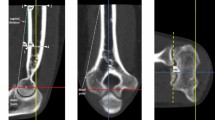Abstract
Introduction
Morphological studies of the humerus have shown that the position of the bicipital groove varies with the individual and the retroversion of the humeral head. Depending on the authors, these two parameters are independent or associated. This study evaluated the relationship between the humeral head axis and its retroversion and the bicipital groove relative to the humeral biepicondylar line.
Materials and methods
Seventy cadaveric humeri were scanned to obtain 3D reconstructions. Views of the 3D reconstruction from above showed the bicondylar line, the bicipital groove and the humeral head on a single image. After measuring the humeral retroversion angle and the bicipital groove angle relative to the bicondylar line, we assessed the relationship between these two angles with Pearson’s correlation coefficient.
Results
Pearson’s correlation coefficient indicated a significant linear correlation between the angle of the groove and the angle of humeral retroversion based on the 70 cadaveric humeral bones (the p-value was 7.510–7, the correlation coefficient was −0.5515, and the 95% confidence interval was (−0.6962; −0.3636)). Our study thus demonstrates that the less lateralized the bicipital groove is, the greater the humeral retroversion will be.
Conclusion
We demonstrated a linear relationship between humeral head retroversion and bicipital groove lateralization. Within our reliability interval, this relationship can be used in clinical practice to evaluate retroversion without resorting to CT of the entire humerus.







Similar content being viewed by others
References
Hitchcook H (1948) Painful shoulder observation on the role of the tendon of the long head of the biceps brachii in its causation. J Bone Joint Surg 30A(2):263–273
Doyle AJ, Burks RT (1998) Comparison of humeral head retroversion with the humeral axis/biceps groove relationship: a study in live subjects and cadavers. J Should Elb Surg Am Should Elb Surg Al 7(5):453–457
Hempfing A, Leunig M, Ballmer FT, Hertel R (2001) Surgical landmarks to determine humeral head retrotorsion for hemiarthroplasty in fractures. J Shoulder Elbow Surg 10(5):460–463. doi:10.1067/mse.2001.117127
Johnson JW, Thostenson JD, Suva LJ, Hasan SA. (2013), Relationship of bicipital groove rotation with humeral head retroversion: a three-dimensional computed tomographic analysis. J Bone Joint Surg Am 95(8): p.719–724. doi:10.2106/JBJS.J.00085
Trouilloud P, Grammont P (1995) Retroversion de la tete humeral et lateralisation de la gouttiere bicipital. In: Chirurgie fonctionnelle de l’epaule. Laboratoire d’anatomie, Faculté de medecine, Dijon, pp 15–23
Wafae N, Atencio Santamaría LE, Vitor L, Pereira LA, Ruiz CR, Wafae GC (2010) Morphometry of the human bicipital groove (sulcus intertubercularis). J Shoulder Elbow Surg 19(1):65–68. doi:10.1016/j.jse.2009.05.005
Author information
Authors and Affiliations
Corresponding author
Additional information
Cadaveric study, Level of Evidence of V
Rights and permissions
About this article
Cite this article
Andrin, J., Pottecher, P., Viard, B. et al. Linear relationship between lateralization of the bicipital groove and humeral retroversion and its link with the biepicondylar humeral line. Anatomical study of seventy cadaveric humerus scans. International Orthopaedics (SICOT) 41, 1431–1434 (2017). https://doi.org/10.1007/s00264-017-3495-1
Received:
Accepted:
Published:
Issue Date:
DOI: https://doi.org/10.1007/s00264-017-3495-1




